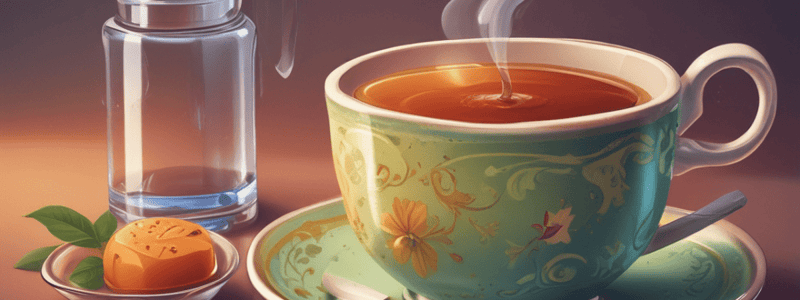Podcast
Questions and Answers
Which of the following spices is commonly used in Masala Chai?
Which of the following spices is commonly used in Masala Chai?
- Ginger
- Cinnamon
- Cardamom
- All of the above (correct)
Black tea is also known as green tea in China.
Black tea is also known as green tea in China.
False (B)
What is the process that halts oxidation in oolong tea?
What is the process that halts oxidation in oolong tea?
Heat treatment
Masala Chai is a spiced milk and tea blend brewed with ____________________ leaves.
Masala Chai is a spiced milk and tea blend brewed with ____________________ leaves.
Match the following types of tea with their characteristics:
Match the following types of tea with their characteristics:
What is the result of the preparation of Masala Chai?
What is the result of the preparation of Masala Chai?
Oolong tea is fully oxidized.
Oolong tea is fully oxidized.
Where do the origins of Black Tea come from?
Where do the origins of Black Tea come from?
What is one of the reasons why tea is not popular in restaurants?
What is one of the reasons why tea is not popular in restaurants?
All tea varieties come from multiple types of evergreen bushes.
All tea varieties come from multiple types of evergreen bushes.
How many servings can be made from one pound of tea?
How many servings can be made from one pound of tea?
The majority of tea consumed in North America is imported from ____________________ and ____________________.
The majority of tea consumed in North America is imported from ____________________ and ____________________.
What is the process of making green tea?
What is the process of making green tea?
Black tea is graded based on flavor characteristics.
Black tea is graded based on flavor characteristics.
Match the following tea types with their processing methods:
Match the following tea types with their processing methods:
What is the maximum number of teas that can be blended together to create a mix?
What is the maximum number of teas that can be blended together to create a mix?
What is the primary usage of SQL?
What is the primary usage of SQL?
Most of the flavor and aroma of tea are preserved during the processing of instant tea.
Most of the flavor and aroma of tea are preserved during the processing of instant tea.
What is the recommended proportion of tea to water when making hot tea?
What is the recommended proportion of tea to water when making hot tea?
When making hot tea, it's recommended to use a teapot made of ______________________ to avoid off flavors.
When making hot tea, it's recommended to use a teapot made of ______________________ to avoid off flavors.
What is the main reason why instant tea is mainly used for iced tea?
What is the main reason why instant tea is mainly used for iced tea?
Match the following tea packaging with their corresponding sizes:
Match the following tea packaging with their corresponding sizes:
Using a tea ball in a small container is a recommended method for serving tea.
Using a tea ball in a small container is a recommended method for serving tea.
What is the recommended steeping time for hot tea?
What is the recommended steeping time for hot tea?
What is unique about oolong tea?
What is unique about oolong tea?
Matcha tea has lower caffeine levels than regular green tea.
Matcha tea has lower caffeine levels than regular green tea.
What are the two popular varieties of oolong tea mentioned in the text?
What are the two popular varieties of oolong tea mentioned in the text?
Herbal teas are brewed using dried _______________________ instead of tea leaves.
Herbal teas are brewed using dried _______________________ instead of tea leaves.
Match the following tea types with their characteristics:
Match the following tea types with their characteristics:
What is a benefit of drinking green tea?
What is a benefit of drinking green tea?
All herbal teas are made with tea leaves.
All herbal teas are made with tea leaves.
What is a characteristic of matcha tea?
What is a characteristic of matcha tea?
Flashcards are hidden until you start studying
Study Notes
Tea Overview
- Tea is one of the most popular beverages worldwide, even in coffee-drinking countries
- Tea is often more popular at home than in restaurants, possibly due to restaurant mismanagement and disinterest
- Serving tea can be cost-effective, as one pound of tea yields 200 servings, compared to 40 servings of coffee
- Tea is a simple beverage to serve, requiring minimal equipment and labor
Types of Tea
- All tea varieties come from a single type of evergreen bush
- Different growing conditions and processing procedures result in varying flavor characteristics and quality
- Tea can be categorized into:
- Black tea: fermented, resulting in a robust flavor profile
- Green tea: unoxidized, preserving natural compounds and offering health benefits
- Oolong tea: partially fermented, with a unique semi-oxidized status
- Specialty and flavored teas: blended for consistency and homogeneity
Types of Black Tea
- Black tea is graded based on leaf size, with orange pekoe being a specific leaf size of any black variety
- Blended teas can comprise up to 30 different teas
- Popular black tea varieties include:
- Assam tea
- Darjeeling tea
- Earl Grey tea
Oolong Tea
- Oolong tea boasts a unique semi-oxidized status, harvested later than green tea
- Leaves undergo controlled bruising, altering oxidation, resulting in diverse flavors influenced by region
- Popular oolong varieties include:
- Ti Kuan Yin (Iron Goddess of Mercy)
- Dan Cong (Phoenix Tea)
Green Tea
- Green tea is renowned for its unoxidized leaves, offering health benefits and a nuanced flavor profile
- Harvested from Camellia sinensis, leaves undergo minimal processing, preserving natural compounds
- Popular green tea varieties include:
- Matcha
- Sencha
- Dragonwell (Longjing)
Matcha
- Matcha tea is made from powdered green tea leaves whisked with hot water
- Rich in chlorophyll, it offers health benefits and a vibrant taste experience
- Matcha is available in ceremonial-grade and culinary-grade varieties
Herbal Teas
- Herbal teas are brewed without tea leaves, using dried fruits, herbs, spices, flowers, and other plant materials
- Hundreds of flavors and blends are available, with popular options including:
- Mint
- Chamomile
Packaging and Market Forms
- Tea comes in various packaging forms, including:
- Pot-size bags (100g to 250g)
- Standard cup-size bags (500g)
- Loose tea in bulk packaging
- Instant tea (a soluble extraction for iced tea)
Preparing Tea
- Proper tea preparation involves:
- Using proper proportions of tea and water
- Rinsing the teapot with hot water to warm it
- Bringing fresh, cold water to a boil
- Letting the tea steep 3 to 5 minutes
- Removing the tea bag or straining off the tea from loose leaves
Studying That Suits You
Use AI to generate personalized quizzes and flashcards to suit your learning preferences.




